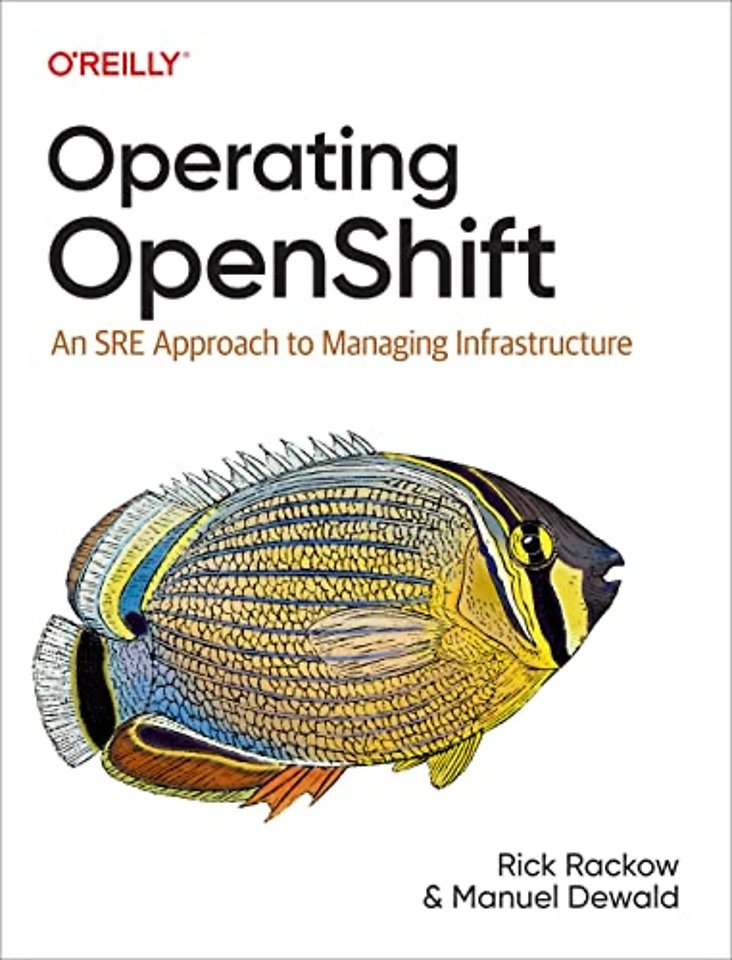Operating OpenShift
An SRE Approach to Managing Infrastructure
Paperback Engels 2022 1e druk 9781098106393Samenvatting
Kubernetes has gained significant popularity over the past few years, with OpenShift as one of its most mature and prominent distributions. But while OpenShift provides several layers of abstraction over vanilla Kubernetes, this software can quickly become overwhelming because of its rich feature set and functionality. This practical book helps you understand and manage OpenShift clusters from minimal deployment to large multicluster installations.
Principal site reliability engineers Rick Rackow and Manuel Dewald, who worked together on Red Hat's managed OpenShift offering for years, provide valuable advice to help your teams operate OpenShift clusters efficiently. Designed for SREs, system administrators, DevOps engineers, and cloud architects, Operating OpenShift encourages consistent and easy container orchestration and helps reduce the effort of deploying a Kubernetes platform. You'll learn why OpenShift has become highly attractive to enterprises large and small.
- Learn OpenShift core concepts and deployment strategies
- Explore multicluster OpenShift Container Platform deployments
- Administer OpenShift clusters following best practices
- Learn best practices for deploying workloads to OpenShift
- Monitor OpenShift clusters through state-of-the-art concepts
Specificaties
Lezersrecensies
Inhoudsopgave
Conventions Used in This Book
Using Code Examples
O'Reilly Online Learning
How to Contact Us
Acknowledgments
1. Introduction
Traditional Operations Teams
How Site Reliability Engineering Helps
OpenShift as a Tool for Site Reliability Engineers
Individual Challenges for SRE Teams
2. Installing OpenShift
OKD, OCP, and Other Considerations
OKD
OCP
OSD, ROSA, and ARO
Local Clusters with OpenShift Local
Planning Cluster Size
Instance Sizing Recommendations
Node Sizing Recommendations
Master Sizing Recommendations
Infra Nodes
Basic OpenShift Installations
Installer-Provisioned Infrastructure
Self-Provisioned Infrastructure
Summary
3. Running Workloads on OpenShift
Deploying Code
Deploying Existing Container Images
Deploying Applications from Git Repositories
Accessing Deployed Services
Accessing Services from Other Pods
Distribution of Requests
Exposing Services
Route by Auto-generated DNS Names
Route by Path
External Load Balancers
Securing Services with TLS
Specifying TLS Certificates
Redirecting Traffic to TLS Route
Let's Encrypt Trusted Certificates
Encrypted Communication to the Service
Summary
4. Security
Cluster Access
Role-Based Access Control
Roles and ClusterRoles
RoleBindings and ClusterRoleBindings
CLI
ServiceAccounts
Threat Modelling
Workloads
Summary
5. Automating Builds
OpenShift Image Builds
Docker Build
Source to Image (S2I) Build
Custom S2I Images
Red Hat OpenShift Pipelines
Overview
Install Red Hat OpenShift Pipelines
Setting Up the Pipeline
Turning the Pipeline into Continuous Integration
Summary
6. In-Cluster Monitoring Stack
Cluster Monitoring Operator
Prometheus Operator
User Workload Monitoring
Visualizing Metrics
Console Dashboards
Using Grafana
Summary
7. Advanced Monitoring and Observability Strategies
Service Oriented Monitoring
Service Level Indicators
Service Level Objectives
Tools
Logging
ClusterLogging
Log Forwarding
Loki
Visualization
Installation
Creating a Grafana Instance
Data Source
Dashboards
Summary
8. Automating OpenShift Cluster Operations
Recurring Operations Tasks
Application Updates
Certificate Renewals
OpenShift Updates
Backups
Automating Recurring Operations Tasks
Persistence
Creating Snapshots
Using CronJobs for Task Automation
Cluster Configuration
Manage Cluster Configuration with OpenShift GitOps
Installing OpenShift GitOps
Managing Configuration with OpenShift GitOps
Managing Configuration of Multiple Clusters with OpenShift GitOps
Summary
9. Developing Custom Operators to Automate Cluster Operations
Operator SDK
Operator Design
Bootstrapping the Operator
Setting Up a CA Directory for Development
Designing the Custom Resource Definition
Installing the CustomResourceDefinition
Local Operator Development
The Reconcile Function
Deploying the Operator
Creating and Updating OpenShift Resources
Specifying RBAC Permissions
Routing Traffic to the Operator
Adding Additional Controllers
Updating Resource Status
Summary
10. Practical Patterns for Operating OpenShift Clusters at Scale
Cluster Lifecycle
Cluster Configuration
Logging
Monitoring
Alerting
Automation
On Call
Primary On Call
Backup On Call
Shift Rotation
Ticket Queue
Incident Management
When to Declare an Incident
Inform the Customer
Define Roles
Incident Timeline
Document the Process
Postmortem
Accessing OpenShift Clusters
The Stage Is Yours
Index
About the Authors
Anderen die dit boek kochten, kochten ook
Rubrieken
- advisering
- algemeen management
- coaching en trainen
- communicatie en media
- economie
- financieel management
- inkoop en logistiek
- internet en social media
- it-management / ict
- juridisch
- leiderschap
- marketing
- mens en maatschappij
- non-profit
- ondernemen
- organisatiekunde
- personal finance
- personeelsmanagement
- persoonlijke effectiviteit
- projectmanagement
- psychologie
- reclame en verkoop
- strategisch management
- verandermanagement
- werk en loopbaan







